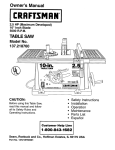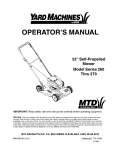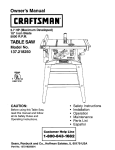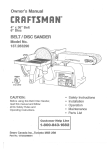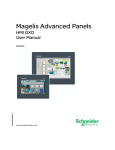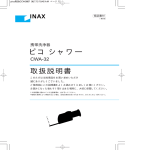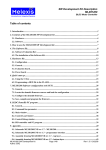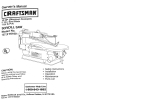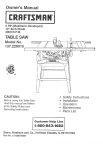Download Craftsman 137.218740 Operating instructions
Transcript
ual
Owner's
®
2.5 HP (Maximum
10" inch Blade
5000 R.P.M.
Developed)
TABLE
ModemNo.
137.218740
CAUTION:
•
.
,
o
,
,
Before using this Table Saw,
read this manual and follow
all its Safety Rules and
Operating Instructions.
Customer
Help
Safety Instructions
Installation
Operation
Maintenance
Parts List
EspaSol
Line
1-800=843-1682
Sears,
Roebuck
and Co., Hoffman
Part No. 137218740002
Estates,
IL 60179
USA
SECTION
GENERAL SAFETY _NSTRUCTIONS
PAGE
Warranty
................................................................
Product Specifications
.......................................
Safety Instructions
........................................................
Accessories
and Attachments
...............................................
Carton Contents
..........................................................
KnowYour
Table Saw ..............................................
Assembly
and Adjustments
.............................................
Operation
..............................................................
Maintenance
...................................................
Troubleshooting
guide ....................................................
Parts ..................................................................
EspaSol ................................................................
BEFORE USING THE TABLE SAW
2
. .............
2
3
6
6
...,
.... 8
".... 9
15
. ........
19
20
22
25
Safety is a combination of common sense, staying alert
and knowing how to use your table saw.
To avoid mistakes that could cause serious injury, do not
plug the [able in until you have read and understood the
following:
1.
2_
KEEP GUARDS IN PLACE and in working order.
3.
REMOVE ADJUSTING KEYS AND WRENCHES.
Form the habit of checking to see that keys and
adjusting wrenches are removed from the tool before
turning "ON".
4.
FULL ONE YEAR WARRANTY
5.
If this product fails due to a defect in material or workmanship within one year from the date of purchase, Sears
will repair it free of charge.
READ and become familiar with this entire instruction
manual. LEARN the tool's applications, limitations, and
possible hazards.
KEEP WORK AREA CLEAN. Cluttered areas and
benches invite accidents.
DON'T USE IN A DANGEROUS ENVIRONMENT.
Don't use power tools in damp or wet locations, or
expose them to rain. Keep work area well lighted.
Contact a Sears Service Center for repair.
.
If this product is used for commercial or rental purposes, this warranty applies only for 90 days from the date of
purchase.
7.
MAKE WORKSHOP KID PROOF with padlocks, master
switches, or by removing starter keys.
8.
DON'T FORCE THE TOOL. It will do the job better
and safer at the rate for which it was designed.
This warranty gives you specific legal rights, and you may also have other rights which vary from state to state.
Sears, Roebuck and Co., Dept. 817 WA, Hoffman
Estates, IL 60179
9.
I
MOTOR
Maximum developed HP .........
Volts ........................
Amperes .....................
Hertz .......................
RPM (no load) ................
2.5
120
13
60
5000
Overload protection .............
YES
SAW
Table .......................
Blade .......................
17 1/8" x 26"
10"
Maximum depth of cut at 90 ° .....
Maximum depth of cut at 45° .....
Maximum width of dado .........
Weight ......................
3 inches
2-1/2 inches
1/2 inch
40 Ibs.
To avoid electrical hazards, fire hazards, or damage to
the tool, use proper circuit protection.
Your table saw is wired at the factory for 120V operation.
Connect to a 120V, 15 AMP branch circuit and use a 15
AMP time delay fuse or circuit breaker. To avoid shock or
fire, replace power cord immediately if it is worn, cut or
damaged in any way.
KEEP CHILDREN AWAY. All visitors should be kept at
a safe distance from the work area.
USE THE RIGHT TOOL. Don't force tool or the
attachment to do a job for which it was not designed.
10. USE PROPER EXTENSION CORD. Make sure your
extension cord is in good condition. When using an
extension cord, be sure to use one heavy enough to
carry the current your product will draw. An undersized
cord will cause a drop in line voltage resulting in loss
of power and overheating. The table on page 5 shows
the correct size to use depending on cord length and
nameplate ampere rating. If in doubt, use the next
heavier gauge. The smaller the gauge number, the
heavier the cord.
11. WEAR PROPER APPAREL. DO NOT wear loose
clothing, gloves, neckties, rings, bracelets, or other
jewelry which may get caught in moving parts.
Nons]ip footwear is recommended. Wear protective
hair covering to contain long hair.
12.
WEA_YOUR
ALWAYS WEAR EYE
PROTECTION. Any table
saw can throw foreign
objects into the eyes which
could cause permanent eye
damage. ALWAYS wear Safety
Goggles (not glasses) that
comply with ANSI safety standard Z87.1. Everyday
eyeglasses have only impact-resistant lenses. They
ARE NOT safety glasses. Safety Goggles are available
at Sears. NOTE: Glasses or goggles not in compliance
with ANSI Z87.1 could seriously hurt you when they break.
13. WEAR A FACE MASK OR DUST MASK.
Sawing operation produces dust.
14. SECURE WORK. Use clamps or a vise to hold work
when practical. It's safer than using your hand and it
frees both hands to operate tool.
before servicing, and when
15. DISCONNECTTOOLS
changing accessories, such as blades, bits, cutters,
and the like.
16. REDUCE THE RISK OF UNINTENTIONAL STARTING.
Make sure the switch is in "OFF" position before
plugging in.
17. USE RECOMMENDED ACCESSORIES. Consult the
owner's manual for the recommended accessories.
The use of improper accessories may cause risk of
injury to persons.
18. NEVER STAND ON TOOL. Serious injury could occur
if the tool is tipped or if the cutting tool is unintentionally
contacted.
19. CHECK FOR DAMAGED PARTS. Before further use of
the tool, a guard or other part that is damaged should
be carefully checked to determine that it will operate
properly and perform its intended function. Check for
alignment of moving parts, binding of moving parts,
breakage of parts, mounting, and any other conditions
that may affect its operation. A guard or other part that
is damaged should be properly repaired or replaced.
20. NEVER LEAVE TOOL RUNNING UNATTENDED.
TURN THE POWER "OFF". Don't leave the tool until
it comes to a complete stop.
21. DON'T OVERREACH.
balance at all times.
22. MAINTAIN TOOLS WITH CARE. Keep tools sharp
and Clean for best and safest performance. Follow
instructions for lubricating and changing accessories.
23. DO NOT use power tools in the presence of flammable
liquids or gases.
SAVE THESE iNSTRUCTiONS
_ii' !
Keep proper footing and
SPECiFiC SAFETY iNSTRUCTiONS
FOR THE TABLE SAW
2.
,
.
14. AVOID AWKWARD
DO NOT MODIFYTHE PLUG PROVIDED. If it will not fit the
receptacle, have the proper receptacle installed by a
qualified electrician.
OPERATIONS and hand
positions where a sudden slip could cause your
hand to move into the cutting tool.
ALWAYS USE SAW BLADE GUARD spreader and
anti-kickback pawls for every operation for which
they can be used, including through-sawing.
Through-sawing operations are those in which the
blade cuts completely through the workpiece
when ripping or cross cutting.
IMPROPER CONNECTION of the equipment grounding
conductor can result in risk of electric shock. The
conductor with the green insulation (with or without yellow
stripes) is the equipment grounding conductor. If repair
or replacement of the electric cord or plug is necessary,
DO NOT connect the equipment grounding conductor to
a live terminal.
15. NEVER USE SOLVENTS to clean plastic parts.
Solvents could possibly dissolve or otherwise
damage the material. Only a soft damp cloth should
be used to clean plastic parts.
ALWAYS HOLDTHE WORK FIRMLY against the
miter gauge or rip fence.
16. MOUNT your table saw before performing any
cutting operations. Refer to installation instructions.
USE A PUSH STICK when required. Always use a
push stick for ripping narrow stock. Refer to ripping
applications in the instruction manual where the
push stick is covered in detail. See the push stick
pattern included in this Owner's Manual.
This tool is intended for use on a circuit that has a
receptacle like the one illustrated in FIGURE A.
FIGURE A shows a 3-prong electrical plug and receptacle
that has a grounding conductor. If a properly grounded
receptacle is not available, an adapter (FIGURE B) can
be used to temporarily connect this plug to a 2-contact
ungrounded receptacle. The temporary adapter should
be used only until a properly grounded receptacle can
be installed by a qualified technician. The adapter
(FIGURE B) has a rigid lug extending from it that MUST
be connected to a permanent earth ground, such as a
properly grounded receptacle box. The Canadian
Electrical Code prohibits the use of adapters.
CAUTION: In all cases, make certain the receptacle in
question is properly grounded. If you are not sure have a
certified electrician check the receptacle.
This table saw is for indoor use only. Do not expose to
rain or use in damp locations.
Fig. A
CHECK with a qualified electrician or service personnel if
you do not completely understand the grounding instructions,
or if you are not sure the tool is properly grounded.
17. NEVER CUT METALS or materials which may make
hazardous dust.
3-Prong Plug
USE ONLY 3-WIRE EXTENSION CORDS THAT HAVE
3-PRONG GROUNDING PLUGS AND 3-POLE
RECEPTACLES THAT ACCEPTTHE TOOL'S PLUG.
REPAIR OR REPLACE DAMAGED OR WORN CORD
IMMEDIATELY.
18. ALWAYS USE IN A WELL VENTILATED AREA.
Remove saw dust frequently. Clean out sawdust
from the interior of the saw to prevent a potential fire
hazard.
NEVER PERFORM ANY OPERATION
"FREE HAND", which means using your hands
only to support or guide the work piece. Always
use either the fence or the miter gauge to position
and guide the work.
INSTRUCTIONS
IN THE EVENT OF A MALFUNCTION OR BREAKDOWN,
grounding provides a path of least resistance for electric
current and reduces the risk of electric shock. This tool
is equipped with an electric cord that has an equipment
grounding conductor and a grounding plug. The plug
MUST be plugged into a matching receptacle that is
properly installed and grounded in accordance with ALL
local codes and ordinances.
13. AVOID KICKBACKS (work thrown back towards
you) by keeping the blade sharp, keeping the rip
fence parallel to the saw blade, and by keeping the
spreader, anti-kickback pawls, and guard in place
and operating. Do not release work before it is
pushed all the way past the saw blade. Do not rip
work that is twisted, warped, or does not have a
straight edge to guide along the fence.
25. Dust generated from certain materials can be
hazardous to your health. Always operate the table
saw in a well-ventilated area and provide for
proper dust removal. Use dust collection systems
whenever possible.
.
GROUNDING
12. PROVIDE ADEQUATE SUPPORT to the rear and
sides of the saw table for wide or long workpieces.
24. DO NOT operate the tool if you are under the influence
of any drugs, alcohol or medication that could affect
your ability to use the tool properly.
lg. NEVER LEAVE THE TOOL running unattended.
Don't leave the tool until it comes to a complete stop.
GUIDELINES
FOR EXTENSION
(b
d).
_a
Prong
Properly Grounded
3-Prong Receptacle
CORDS
Fig. B
5.
NEVER STAND or have any part of your body
in line with the path of the saw blade. Keep your
hands out of the line of the saw blade.
6.
NEVER REACH behind or over the cutting tool
for any reason.
7.
REMOVE the rip fence when cross-cutting.
8.
DO NOT USE molding head set with this saw.
9.
FEED WORK INTO THE BLADE against the
direction of rotation only.
20. For proper operation follow the instructions of this
owner's manual titled "SAW MOUNTED TO WORK
USE PROPER EXTENSION CORD. Make sure your
extension cord is in good condition. When using an
extension cord, be sure to use one heavy enough to carry
the current your product will draw. An undersized cord will
cause a drop in line voltage resulting in loss of power and
overheating. The table below shows the correct size to
use depending on cord length and nameplate ampere
rating. If in doubt, use the next heavier gauge. The smaller
the gauge number, the heavier the cord.
SURFACES." Failure to provide sawdust fall-through
and removal hole will allow sawdust to build up in
the motor area, which may result in a fire hazard or
cause motor damage.
Be sure your extension cord is properly wired and in
good condition. Always replace a damaged extension
cord or have it repaired by a qualified person before
using it. Protect your extension cords from sharp objects,
excessive heat and damp or wet areas.
10. NEVER use the fence as a cut-off gauge when
cross-cutting.
I
:
::
:
:
Use a separate electrical circuit for your tools. This circuit
must not be less than #12 wire and should be protected
with a 15 Amp time lag fuse. Before connecting the motor
to the power line, make sure the switch is in the "OFF"
position and the electric current is rated the same as the
current stamped on the motor nameplate. Running at a
lower voltage will damage the motor.
SAVE THESE iNSTRUCTiONS
::
-- Make Sure This
is Connected to a
Known Ground
4
: ;:
This tool must be grounded while in use to protect the
operator from electrical shock.
e_
(when
:
using
-
120 volts
{I
O_l
•
only)
Ampere Rating
Totallengthofeordin
25'
50'
100'
150'
o
6
18
16
16
14
10
18
16
14
12
10
12
12
16
16
16
14
12
14
12
Not
Recommended
more
6
than
not mare than
SAVE THESE iNSTRUCTiONS
:
"" 2-Prong
Receptacle
Adapter
i
11. NEVER ATTEMPTTO FREE A STALLED SAW
BLADE without first turning the saw OFE Turn
off power switch immediately to prevent motor
damage.
:
Grounding Lug
feet
UNPACKING
AVAILABLE
YOUR TABLE SAW:
UNPACKING AND CHECKING CONTENTS
ACCESSORIES
TOOLS NEEDED
Visit your Sears Hardware Department or see the Sears
Power and Handtool Catalog for the following accessories:
Medium screwdriver
ITEM
-
o
o
-
ITEM NUMBER
Adjustable wrench
Saw blades .............
See catalog or store
Table Saw
and Bench Power Tool
Know How Manual ...................
29115
Guide Master Table
Saw Push Shoe .....................
32190
Taper Jig ...........................
3233
Fence Guide System ..................
3237
6 inch Dado Set ....................
32175
#2 Phillips screwdriver
I II[tll!ll
Ill
c
Combination sc uare
Straight edge
Separate all parts from packing material. Check each one
with the illustration and the list of loose parts [o make
certain all items are accounted for, before discarding any
packing material.
If any parts are missing or damagee, do not attempt to
assemble the table saw, plug in the power cord, or turn
the switch on until the missing or damaged part is
obtained and is installed correctly.
Do not use adjustable (wobble) type dadoes or carbide
tipped dado blades on this saw. Maximum dado width is
1/2". Do not use a dado with a diameter larger than 6".
Also do not use molding head set with this saw.
TABLE
Sears may recommend other accessories not listed in
this manual.
See your nearest Sears store or Power and Hand Tool
Catalog for other accessories.
Do not use any accessory unless you have completely
read the instruction or owner's manual for that accessory.
Use only accessories recommended for this saw. Using
other accessories may be dangerous.
OF LOOSE
PARTS
ITEM
DESCRIPTION
A.
B.
C.
D.
E.
R
G.
Table saw assembly
Blade guard and splitter
Rip fence and qandle
Hand wheel
Flat washer, nut
Dade insert
Mitre gauge and knob
Loose parts:
Support rod
Stop rod
Wing nut
Holder plate
Clamp plates
Bolt
Square nut
Cap head bolt
Bolt,flat washer, tooth washer,
washer
H.
I.
J.
K.
h
M.
N.
O.
R
Q.
R.
S.
T.
U.
Screws
Nuts
Storage bracket
Hex key
Blade wrenches
QUANTITY
1
1
1
F
H
]
1
1
1
1
1
1
1
2
1
1
1
!
J
K
L
M
N
O
P
2
2
1
1
2
Q
NOTE:
To make assembly easier, keep contents of box together.
Apply a coat of automobile wax to the table. Wipe all parts
thoroughly with a clean dry cloth. This will reduce friction
when pushing the workpiece.
6
G
R
S
T
U
Miter Gauge
Blade Guard
ASSEMBLY
Table Insert
DNSTRUCTmONS
Fig. D
Rip Fence
MOUNTING SAWTO WORK SURFACES (FIG. C)
1. A sawdust fall-through hole must be provided in the
work surface where the saw is to be mounted.
2. Position the saw on the work surface and mark the
location of the four table saw mounting holes.
3. Drill holes into the work surface.
4. Mark an 11" square (2) centered between the four
mounting holes (1).
5. Cut out and remove the square piece.
6. This opening will allow sawdust to fall through the
saw base.
7. Fasten the saw to the work surface with appropriately
sized bolts, nuts and washers.
Suppodrod
.Table
Stop rod
Blade Bevel Scale
Blade Bevel Lock Handle
Storage Bracket
Fig. C
Fag. E
On-Off Switch with Key
levation Handwheel
@
Mounting Holes
Overload Reset
BLADE RAISING HAND WHEEL (FIG. E,F)
1. Attach the hand wheel (1) to the elevation screw (2).
Make sure the slots (3) in the hub of the handwheel
engage with the pins (4).
2. Tighten the screw nut (5) at the end of the shaft (Fig. F).
@
2
3
Blade Wrenches
Dado Insert
@
@
Fig. F
Splitter
Failure to provide the sawdust fall-through hole will cause
sawdust to build up in the motor area, which may result
in fire or cause motor damage.
Blade
Kickback Pawls
]
KEEPING THE AREA CLEAN (FIG. D)
1. Saw dust and wood chips that fall from under the
saw will accumulate on the floor.
2. Make it a practice to pick up and discard this dust
when you have completed cutting.
Splitter Bracket
Always keep your work area clean, uncluttered and well
lit. Do not work on floor surfaces that are slippery from
sawdust or wax.
Cord bracket
\
¸%¸¸/
4
RIP FENCE (FIG. G)
1. Thread the fence handle (1) into the cam hole (2)
until tight.
2. Lift upward on the rip fence handle (1) so that the
holding clamp (3) is fully extended.
3. Place the rip fence on the saw table and engage
the holding clamp (3) to the table rear. Lower the
front end onto the front rail (4).
4. Push down on the fence handle (1) to lock.
2.
Raise the blade arbor (3) (FIG. I) to the maximum
height by turning the blade raising hand wheel
counterclockwise.
BLADE GUARD ASSEMBLY
3.
4.
Remove the arbor nut (4) and flange (5).
Install the saw blade onto the arbor with the blade
teeth pointing toward the front of the saw.
Install the flange (5) against the blade and thread the
arbor nut (4) as far as possible by hand. Ensure that
the blade is flush against the inner blade flange.
To avoid injury from an accidental start, make sure the
switch is in the "OFF" position and the plug is not
connected to the power source outlet.
5.
Fig. I
3.
4
3
6.
7.
8.
9.
1.
2.
Fig. G
(FIG. K, L, M, N)
Set the blade to maximum height and the tilt to zero
degrees on the bevel scale. Lock the blade lock knob.
Place the external tooth Iockwasher (2) followed by a
flat washer (3) onto the long bolt (1).
Insert this bolt through the splitter bracket (4).
Fig. K
Position the blade guard arm (9) (FIG. N) to the rear.
Using a straight edge, check to see that the blade
guard splitter (10) is aligned with the saw blade (11).
If straightening adjustment is necessary, loosen
bolt (I) and shift the splitter assembly (10) to the left
or to the right, or rotate as needed.
When you are certain the splitter (10) is properly
aligned with the saw blade, tighten the bolt (1).
NOTE: The splitter (10) must always be correctly
aligned so that the cut workpiece will pass on either
side of the splitter without binding or twisting to the
side.
Fig. N
10
-
9
1
4.
6.
CHANGING THE BLADE (FIG. H, I, J)
7.
8.
To avoid injury from an accidental start, make sure the
switch is in the "OFF" position and the plug is not
connected to the power source outlet.
To tighten the arbor nut (4) (FIG. J) use the open-end
wrench (5) and align the wrench jaws on the flats of
the saw arbor to keep the arbor from turning.
Place the box-end wrench (6) on the arbor nut (4),
and turn clockwise (to the rear of the saw table.)
Replace the blade insert in the table recess, insert
screws through the front and rear holes and tighten.
Place washer (6) on the pivot rod (5). Then insert the
blade guard splitter bracket onto the pivot rod
and tighten.
Fig. L
Fig. J
Remove the table insert (1) by unscrewing the two
screws (2). Be careful not to lose the rubber washer
that is on the back screw beneath the table insert.
MITER GAUGE STOP ROD ASSEMBLY (FIG. O)
1. Assemble the stop rod (1) and support rod (2) with
the two clamp plates (3).
2. Insert a cap head square neck bolt (4) through the
clamp plates, and fasten with the wing nut (5).
3. Place the stop rod assembly in the miter gauge
recess (6).
4. Placing the holder plate (7) over the support rod,
secure it with a bolt (8) and square nut (9).
5. To adjust for different size workpieces, loosen the
wing nut (5) or the bolt (8), and lengthen or
shorten them.
Fig. 0
NOTE: The back screw is longer than the
front screw.
5.
Fig. H
Check that the nuts (7) that hold the blade guard
assembly (8) to the splitter bracket (4) are tight.
Tighten if necessary.
Fig. M
2
To avoid injury from a thrown workpiece, blade
parts, or blade contact, never operate saw without
the proper insert in place. Use the saw blade
insert when sawing. Use the dado head insert
when using a dado.
i
/f4
STORAGE BRACKET ASSEMBLY (FIG. Q)
For convenient storage of accessories, install the bracket
on the side of the table saw housing. Insert a pan Ilead
screw (1) through the storage bracket (2) and attach to
the housing, as shown. Place a nut (3) on each screw
from the inside of the housing, and tighten.
Fig.Q
Fig. R
RIP FENCE INDICATOR ADJUSTMENT (FIG. S)
1. The rip fence indicator (6) points to the
measurement scale (8). The scale shows the
distance from the side of the fence to the nearest
side of the blade.
2. Measure the actual distance with a rule. If there is a
difference between the measurement and the
90°
O
uU
1
2
RIP FENCE ADJUSTMENT
ADJUSTMENT
iNSTRUCTiONS
2.
3.
MITER GAUGE ADJUSTMENT (FIG. R)
1. Make sure that the miter gauge will slide freely
through both table grooves.
2. Loosen the lock knob (1). Set pointer (2) at the 90 °
mark on the scale.
3. Using a piece of scrap wood, make a 90° cut. Then
check the cut piece to see if it was cut at 90 °. If not
90 °, continue to adjust the miter gauge body (3) until
the wood piece is cut at 90 °.
4. When a 90 ° degree cut has been made, loosen the
pointer screw (4) and set on the 90 ° s,eale mark.
Tighten screw.
4.
5.
6.
The fence (1) is moved by lifting up on the handle (2)
and sliding the fence to the desired location. Pushing
down on the handle (2) locks the fence in position.
Position the fence on the right side of the table, and
along one edge of the miter gauge grooves.
Lock the fence handle (2). The fence should be
parallel with the miter gauge groove.
If adjustment is needed to make the fence parallel to
the groove, do the following:
Loosen the two screws (3) and lift up on the handle (2).
Hold the fence bracket (4) firmly against the front of
the saw table. Move the far end of the fence until it is
parallel with the miter gauge groove.
Tighten both screws (3) and push the handle (2) to lock.
If fence is loose when the handle is in the locked
(downward) position, do the following.
9. Move the handle (2) upward and turn the adjusting
screw (5) clockwise until the rear clamp is snug. Do
not turn the adjusting screw (5) more than 1/4 turn at
a time.
10. Over-tightening the adjusting screw (5) will cause the
fence to come out of alignment.
7.
8.
Fig. S
1
4
To avoid injury from an accidental start, make sure the
switch is in the "OFF" position and the plug is not
connected to the power source outlet.
ADJUSTING THE 90 ° AND 45 ° POSITIVE STOPS
(FIG. T, U)
Your saw has positive stops that wilt quickly position the
saw blade at 90 ° or 45 ° to the table. Make adjustments
only if necessary.
90 ° Stop
t. Disco_lnect the saw from the power soulce.
2. liJrn the blade elevation handwheel and raise the
blade to the maximum elevation.
3. Loosen the blade bevel kx:k handle (2) and move Ihe
blade to ihe maximum verlical position. Tighten Ihe
lock handle (2),
4. Place a combination square orl tile table and
against lhe blade (t) to delermine il Ihe blade
isg0 °tothe tahle (FIG.])
5. I[ tile blade is not g0° !o ._hetable, loosen Ihe screw (3).
6. Loosen the bevel lock handle (2) and move the blade
until it is 90 _' to the table.
7. Tighten the bevel lock handle (2).
8. Tig hten the screw (3) until resistance is felt.
Do not overtighten.
g. Check the bevel angle scale. If the pointer does
not read 90 ° , loosen the screw holding the pointer and move the pointer so it reads correctly.
Retighten the pointer screw.
90°
45 ° Stop
1. With the blade in the upright 90 ° position, loosen the
bevel lock knob and move the blade to the 45 °
position as far as it will go.
2. Place the combination square on the table as shown
in (FIG. T) to check if the blade is 45 ° to the table.
3. If the blade is not 45" to the table, adjust the
screw (4) with a screw driver until the blade is
45 " to the table.
4. Tighten the bevel lock handle (2).
5. Tighten the screw (4) until resistance is felt.
Do not overtighten.
BLADE TILT INDICATOR
1.
2.
When the blade is positioned 'at 90°, adjust the
blade tilt pointer to read 0 ° on timescale.
Loosen the holding screw, position pointer over 0°
and tighten screw.
45°
NOTE: Make a trial cut on scrap wood when making
critical cuts. Measure for exactness.
L_ k__ X_ X__'
-T-r_
4
2_
1
indicator, adjust the indicator (6).
Loosen the screw (7) and slide indicator (6)ito the
correct measurement scale. Tighten screw and
remeasure with the rule.
Fig.T
_3
8675
3
(FIG. S)
To avoid injury from an accidental start, make sure
the switch is in the "OFF" position and the plug is
not connected to the power source outlet.
1.
3.
Fig. U
BLADE PARALLEL TO THE MITER GAUGE GROOVE
(FIG. V)
To prevent personal injury, always disconnect plug from
the power source when making any adjustments.
ADJUSTING THE BLADE TO BE PARALLEL TO
THE MITER GAUGE GROOVE (FIG. W)
1. If the front and rear measurements are not the
same, remove the combination square and loosen
the four adjusting screws (1) on the top of the table
about a half turn.
2.
This adjustment was made at the factory, but it should
be rechecked and adjusted if necessary.
3.
This adjustment must be correct or kickback could result
and accurate cuts cannot be made.
1.
2.
3.
4.
5.
6.
7.
8.
9.
Remove the yellow switch key and unplug
the saw.
Move the blade guard out of the way.
Raise the blade to the highest position and set at
the 0 ° angle (90 ° straight up).
Select and mark, with a felt tip marker, a blade
tooth having a "right set".
Place the combination square base (1) into the
right side miter gauge groove (2). (FIG. V)
Adjust the rule so it touches the front marked tooth
and lock ruler so it holds its position in the square
assembly.
Rotate the blade bringing the marked tooth to the
rear and about 1/2 inch above the table.
Carefully slide the combination square to the rear
until the ruler touches the marked tooth.
If the ruler touches the marked tooth at the front and
rear positions, no adjustment is needed at this time.
4.
5.
6.
With a folded piece of cardboard covering the blade
to protect your hands, move the blade carefully to
the left or right as much as needed to align
the blade correctly.
Tighten the four screws (1) and remeasure, as
described in steps 4 to 9 in the prior section.
If sufficient adjustment cannot be made by the
adjusting screws (1), then also loosen the two
adjustment screws (2). Loosen these screws (2)
only if necessary.
Recheck blade clearance making sure that the
blade does not hit the table insert or other parts
when at the 90° and 45° settings.
Tighten all screws.
BASIC SAW OPERATIONS
Fig. Y
RAISING THE BLADE (FIG. X)
To raise or lower the blade, turn the blade elevation
handwheel (1) to the desired blade height, and
then tighten lock handle (2) to maintain the desired
blade angle.
RESET
Fig. X
1
OVERLOAD PROTECTION (FIG. Y)
This saw has a reset overload relay button (3) that will
restart the motor after it shuts off due to overloading or
low voltage. If the motor stops during operation, turn the
ON/OFF switch to tile OFF position. Wait about five
minutes for the motor to cool. Push in on the reset button
(3) and turn the switch to the ON position.
Fig. W
The ON / OFF switch should be in the OFF position, and
the plug removed from the power source while the cool
down takes place to prevent accidental starting when the
reset button is pushed. Overheating may be caused by
misaligned parts or dull blade. Inspect your saw for
proper setup before using it again.
TILTING THE BLADE
Two methods are available for tilting the saw blade.
Fig. V
Rapid blade tilting
Loosen blade lock handle (2), move the hand wheel (1)
to the desired angle and tighten lock handle.
CUTTING OPERATIONS
There are two basic types of cuts: ripping and
crosscutting. Ripping is cutting along the length and
the grain of the workpiece. Crosscutting is cutting
either across the width or across the grain of the
workpiece. Neither ripping nor crosscutting may be
done safely freehand. Ripping requires the use of the
rip fence, and crosscutting requires the miter gauge.
Fine adjustment blade tilting
Loosen blade lock handle (2), push in hand wheel (1)
and at the same time turn the hand wheel (1) to tilt the
saw blade. When the saw blade is at the desired angle,
tighten lock handle (2).
2
1
3
ON / OFF SWITCH (FIG. Y)
The ON / OFF switch has a removable key. With the key
removed from the switch, unauthorized and hazardous
use by children and others is minimized.
1. To turn the saw ON, insert key (1) into the slot in the
switch (2). Move the switch upward to the ON position.
2. To turn the saw OFF, move the switch downward.
3. To lock the switch in the OFF position, grasp the end
(or yellow part) of the switch toggle (1), and pull it out.
4. With the switch key removed_the switch will not operate.
5. If the switch key is removed while the saw is running,
it can be turned OFF but cannot be restarted without
inserting the switch key (1).
CAUTION: Before using the saw each and every time,
check the following:
1.
2.
3.
4.
5.
Blade is tight on the arbor.
Bevel angle lock knob is tight.
If ripping, fence knob is tight and fence is parallel
to the miter gauge grooves.
Blade guard is in place and working properly.
Safety glasses are being worn.
The failure to adhere to these common safety rules, and
those printed in the front of this manual, can greatly
increase the likelihood of injury.
15
RIPPING
Fig. AA
(FIG. Z, AA)
Keep both hands away from the blade and the path
of the blade.
Do not allow familiarity gained from the frequent use of
your table saw to cause careless mistakes. Remember
that even a careless fraction of a second is enough to
cause a severe injury.
1.
2.
3.
4.
5.
Remove the miter gauge. Secure the rip fence to
the table.
Raise the blade so it is about 1/8" higher than the
top of the workpiece.
Place the workpiece flat on the table and against the
fence. Keep the workpiece about 1" away from the blade.
6.
5.
Turn the saw ON and wait for the blade to come up
to speed.
Slowly feed the workpiece into the blade by pushing
forward only on the workpiece section (1) that will
pass between the blade and the fence. (FIG. Z)
BEVEL RIPPING
This cut is the same as ripping except the blade bevel
angle is set to an angle other than 0 °.
AVOID KICKBACK by pushing forward that section of the
workpiece that will pass between the blade and the fence.
Cut only with the workpiece and the fence on the right
side of the blade.
I
RIPPING SMALL PIECES
Avoid injury from blade contact. Never make through-saw
cuts narrower than 1/2" wide.
,
2.
2
1
It is unsafe to rip small pieces. Instead, rip a larger
piece to obtain the size of the desired piece.
When a small width is to be ripped and your hand
cannot be safely put between the blade and the
rip fence, use one or more push sticks to move
the workpiece.
CROSSCUTTING
6.
7.
8.
9.
Fig. DD
Fig. BB
CAUTION: The workpiece must have a straight edge against
the fence and must not be warped, twisted, or bowed.
4.
Start the saw and wait for the blade to come up to
full speed.
Keep the workpiece against the face of the miter
gauge and flat against the face of the gauge and flat
against the table. Then slowly push the workpiece
through the blade (FIG. BB).
Do not try to pull the workpiece back with the blade
turning. Turn the switch OFF, and carefully slide the
workpiece out when the blade is completely stopped.
COMPOUND MITER CROSSCUTTING (FIG. DD)
This sawing operation is combining a miter angle with a
bevel angle.
1. Set the miter gauge to the desired angle. Use only
the left side groove.
2. Set the blade bevel to the desired angle.
3. Carefully push the miter gauge to begin the
cutting operation.
Keep your thumbs off the table top. When both of your
thumbs touch the front edge of the table (2), finish the
cut with a push stick.
The push stick (3) should always be used when the
ripped workpiece is 2" or wider (1). (FIG. AA)
Continue pushing the workpiece with the push stick
(3) until it passes the blade guard and clears the rear
of the table.
Never pull the workpiece back when the blade is
turning. Turn the switch OFR When the blade
completely stops raise the anti-kickback pawls on
each side of the splitter and slide the workpiece out.
16
(FIG. BB)
Do not allow familiarity gained from the frequent use of
your table saw to cause careless mistakes. Remember
that even a careless fraction of a second is enough to
cause a severe injury.
1.
2.
3.
Remove the rip fence and place the miter gauge in
the left side groove.
Adjust the blade height so it is 1/8" higher than the
top of the workpiece.
Hold the workpiece firmly against the miter gauge
with the blade path in line with the desired cut
location. Move the workpiece to one inch distance
from the blade.
BEVEL CROSSCUTTING (FIG. CC)
This cutting operation is the same as crosscutting except
the blade is at bevel angle other than 0 °.
1. Adjust the blade to the desired angle, and tighten the
blade bevel lock knob.
2. Always work to the left side of the blade. The miter
gauge must be in the left side groove.
Fig. CC
MITERING (FIG. EE)
This sawing operation is the same as crosscutting except
the miter gauge is locked at an angle other than 90 °.
1. Hold the workpiece firmly against the miter gauge.
2. Feed the workpiece slowly into the blade to prevent
the workpiece from moving.
Fig. EE
USING WOOD FACING ON THE RIP FENCE (FIG. FF)
When performing some special cutting operations, add
a wood facing (1) to either side of the rip fence (2):
1. Use a smooth straight 3/4" thick wood board (1) that
is as long as the rip fence.
2. Attach the wood facing to the fence with wood
screws (3) through the holes in the fence. A wood
fence should be used when ripping material such as
thin paneling to prevent the material from catching
between the bottom of the fence and the table.
Fig. FF
÷--":........
2
DADO CUTS (FIG, HH)
1. The dado table insert is included with this saw.
Remove saw blade, blade guard, installed dado,
and dado table insert.
2. Instructions for operating the dado are packed with
the separately purchased dado set.
3. The arbor (1) on this saw restricts the maximum
width of the cut to 1/2".
4. It is not necessary to install the outside flange (2)
before screwing on the arbor nut (3). Make sure that
the arbor nut (3) is tight, and that at least one thread
of the arbor sticks out past the nut.
5. Use only the 6" dado set and keep the width 1/2" or
less. It will be necessary to remove the blade guard
and splitter when using dado. Use caution when
dado is operating.
6. Use only the correct number of round outside blades
and inside chippers as shown in the dado set's instruction
manual. Blade or chipper must not exceed 1/2".
7. Check saw to ensure that the dado will not strike the
housing, insert, or motor when in operation.
2.
3.
4.
5.
6.
Attach the stop rod assembly (2) to the miter gauge.
The miter gauge must be in the left-of-the-blade slot.
Measure and set the desired distance from the end
of the stop rod to one blade tooth set to the left.
Place the squared workpiece end against the stop rod.
Hold the workpiece (1) firmly against the miter gauge
body with your left hand and grip the lock knob (3) with
your right hand.
Carefully slide the workpiece into the blade and make
the cut.
Fig. GG
,/
1.
Clean out all sawdust that has accumulated inside
the saw cabinet and the motor.
2.
Polish the saw table with an automotive wax to keep
it clean and to make it easier to slide the workpiece.
Clean cutting blades with pitch and gum remover.
A worn, cut, or damaged power cord should be
replaced immediately.
3.
4.
All electrical or mechanical repairs should be attempted
only by a trained repair technician. Contact the nearest
Sears Service Center for service. Use only identical
replacement parts. Any other parts may create a hazard.
5.
J
Use liquid dish washing detergent and water to
clean all plastic parts.
NOTE: Certain cleaning chemicals can damage
plastic parts.
6.
\
"3
7.
For your own safety, always replace the blade, blade
guard assembly, and blade insert when you are finished
with the dado operation.
Fig. II
For your own safety, turn the switch OFF and remove the
switch key. Remove the plug from the power source outlet
before maintaining or lubricating your saw.
Avoid use of the following cleaning chemicals or
solvents: gasoline, carbon tetrachloride, chlorinated
solvents, ammonia and household detergents
containing ammonia.
Inspect cutting blade for missing teeth or other damage.
If any damage is evident replace blade before using.
BLADE RAISING AND TILTING MECHANISM
After each five hours of operation, the blade raising
mechanism and tilting mechanism should be checked for
looseness, binding, or other abnormalities. With the saw
disconnected from the power source, turn the saw
upside down and alternately pull upward and downward
on the motor unit. Observe any movement of the motor
mounting mechanism. Looseness or play in the blade
raising screw (1) (FIG. II) should be adjusted as follows:
3.
2
SAW
GENERAL MAINTENANCE
1.
2.
5
YOUR TABLE
Fig. HH
o
REPETITIVE CUTTING (FIG. GG)
To crosscut a quantity of workpieces the same length
without having to mark each one, attach the stop rods to
your miter gauge. Use the stop rods only for cutting
duplicate workpieces 6" or longer.
1. Square one workpiece end on alt of the workpieces (1)
to be cut.
MAINTAINING
Loosen nut (2).
Adjust nut (3) until it is finger-tight against the
bracket (4), then back off the nut (3) 1/6 turn.
Tighten nut (2) while holding nut (3). Maximum
allowable play of screw rod (1) is 4 ram.
/
/
Place a small amount of dry lubricant such as graphite
or silicon on screw rod (1) at thrust washer (5). Do not
oil threads of screw rods (1). Screw rod (1) must be
kept clean and free of saw dust, gum, pitch, and other
contaminants for smooth operation.
If excessive looseness is observed in any other part of the
blade raising mechanism or tilting mechanism, take the
complete unit to a Sears Authorized Service Center.
LUBRICATION
All motor bearings are permanently lubricated at the
factory and require no additional lubrication.
On all mechanical parts of your table saw where a
pivot or threaded rod are present, lubricate using
graphite or silicone. These dry lubricants will not
hold sawdust as would oil or grease.
/J
TROUBLESHOOTING
GUIDE
o
0
Z
o_
i---
To avoid injury from an accidental
start, turn the switch "OFF" and always remove the plug from the power source
before making any adjustments.
° Consult your local Sears Service Center if for any reason the motor will not run.
SYMPTOM
POSSIBLE
Saw will not start
CAUSES
1, Saw not plugged in
2. Fuse blown or circuit breaker tripped
3, Cord damaged
CORRECTIVE
1,
2.
3.
Plug in saw
Replace fuse or reset circuit breaker
Have cord replaced by a Sears
Authorized Service Center
1. Positive stop not adjusted correctly
2. Tilt angle pointer not set accurately
2.
Material pinches blade
when ripping
1. Rip fence not aligned with blade
2. Warped wood, edge against
fence is not straight
1.
2.
Check and adjust rip fence
Select another piece of wood
Material binds on splitter
1, Splitter not aligned correctly
with blade
1.
Check and align splitter with blade
Saw makes
unsatisfactory
1. Dull blade
2. Blade mounted backwards
3. Gum or pitch on blade
1.
2,
3,
4. Incorrect blade for work being done
5. Gum or pitch on table
causing erratic feed
4.
5.
1,
2.
3.
4.
5.
6.
Rip fence out of alignment
Splitter not aligned with blade
Feeding stock without rip fence
Splitter not in place
Dull blade
The operator letting go of material
before it is past saw blade
7. Miter angle lock knob is not tight
1.
2.
3.
4.
5,
6.
7.
Align rip fence with miter gauge slot
Align splitter with blade
Install and use rip fence
Install and use splitter (with guard)
Replace blade
Push material all the way past saw
blade before releasing work
Tighten knob
Blade does not
raise or tilt freely
!.
1.
Brush or blow out loose dust and dirt
Blade does not
come up to speed
1, Extension cord too light
or too long
2. Low house voltage
1.
Replace with adequate size cord
2,
Contact your electric company
1. Saw not mounted securely to
workbench
2. Bench on uneven floor
1,
Tighten all mounting hardware
2.
Material kicked back
from blade
Machine vibrates
excessively
Does not make accurate
45 ° and 90 ° cross cuts
Sawdust and dirt in raising
and tilting mechanisms
-d 03
<r.
©
/
0
o
0
N=
.-_"C._Q
I---040
....
"_
O0 .,- "F
-r"
";'." r-
oo S
Check blade with square and adjust
positive stop
Check blade with square and adjust
pointer to zero
/
3. Damaged saw blade
3.
Reposition on flat level surface.
Fasten to floor if necessary.
Replace blade
1. Miter gauge out of adjustment
1.
Adjust miter gauge
/
0
"r-
/
•
/
0
0
¢
Replace blade
Turn blade around
Remove blade and clean with
turpentine and coarse steel wool
Change the blade
Clean table with turpentine
and steel woo!
/
>,
ACTION
Does not make
accurate 45 ° and
90 ° rip cuts
cuts
1.
0
o
/
/
/
/
•
x:::
r"_.
0
.,.., .___-
x::
>_ =
o
/
/
/
/
/
o
,_
o
0
(D _
,,
J
J
/
/
0
Q)
2J
Q_
o
,e_
0
0
_
O9
o
Q)
_
10,':TABLE
10" TABLE SAW PARTS
LIST
MODEL
SAW PARTS LIST
:
88
26
Always order by PART NUMBER, not by key number
Part No.
Description
1
2
3
4
5
6
7
8
9
10
14900126
14900203
14900379
2653MZDE11
19600101
14900602
19814801
2536MBE604
14901102
14901203
Body shell
Segment gear
Label
Truss hd. tapping screw
Tension handle assembly
Wheel
Handle bar
Spring pin
Height regulating bolt
Saddle
11
12
13
t4
15
16
17
18
18A
19
14901302
2603BBLA66
14901501
2701FZD113
14901703
2504MZB006
2668BZDA23
2851D55G05
2898DB7G06
28605BH071
Spring
Hex soc. set screw
Pointer bracket
Hex nut
Needle pointer
Internal tooth lock washer
Pan hd. screw
Rocker switch element
Rocker switch
Switch key
20
21
22
23
24
25
26
27
28
29
14902302
2307BY06CA
2801ABRF01
2709FZDA02
14902807
14902906
14903101
2501MBDN08
2701F Be113
2621BZDA18
Switch box
Power cable
Strain relief
Hex nut and flat washer
Table
Scale
Insert
Flat washer
Crown nut
Pan hd. screw
30
31
32
33
34
35
36
37
38
39
2504MZC005
2604BBLA42
2668BEDA43
2638BZDBA9
18625501
2501NZDN16
2504MZC004
18625601
2501NBDN16
2501MZDNO8
External tooth lock washer
Hex see, countersunkhd screw
Pan hd screw
Count hd. screw
Hex wrench
Flat washer
External tooth lock washer
Wrench
Flat washer
Flat washer
40
41
42
43
44
45
46
47
48
2853D55502
2501NNHN34
2801ABRG01
2668BZDA24
2651MHDB12
2660MBCE14
83990121
14905603
2690MZD515
Circuit breaker switch
Flat washer
Strain relief
Pan hd. screw
Count hd. tapping screw
Pan hd. tapping screw
Cord clamp
Plate cover
Rivet
Size
Qty,
M4x16-12
M10x1.5-12
MSxl 25 T=6.5
_8x18-2
5
M6x1.0-25
MSx1.0-30
0-50
1/4x3/4-3/64
t/4x3/4-!/16
8x16-2.5
3/8x3/4-5/64
M5x0.8-12
M4x16-10
Mlx16-16
Key No.
Part No,
Description
1
1
1
4
1
1
1
1
1
1
80
81
82
83
84
85
86
87
88
89
14608001
14912205
14912301
2601BZDA45
2501MZDN06
2705FZD105
2690MZD514
14912801
14912905
2570DBN606
Pin
Blade guard
Arm
Hex hd bolt
Flat washer
Lock nut
Rivet
Bush
Splitter
Self-locking ring
1
1
1
1
1
1
1
1
1
1
90
91
92
93
94
95
96
97
98
99
14206601
14913201
14206901
14205301
2570DBN606
2536MBE613
2601BZDA47
2504MZC006
2501NZDN16
14205001
Kick back pawl
Bush
Roll pin
Spring
Self-locking ring
Spring pin
Hex hd. boll
External tooth lock washer
Flat washer
Guard bracket
1
1
1
1
1
1
1
1
1
1
100
101
102
103
104
105
106
107
108
109
14523301
29835L5006
2601BZDA41
2608BBLA32
2701FBD108
14914701
14914802
14914901
14208001
18623801
Compression spring
Steel ball
Hex hd. bolt
Hex soc truss hd screw
Hex nut
Cup
Bracket tilt
Washer
Kick back pawl
Compression spring
2
6
1
4
1
4
2
1
1
1
110
1t 1
112
113
114
115
116
117
118
119
18622201
18622701
2536MBE608
2501MBDN28
2801FZD113
14916101
14916201
2672BZDA27
14916401
14916501
Eccentric
Cap screw
Spring pin
Washer
F_at washer
Bolt
Follower plate
Cap hd. sq, neck bolt
Blade holder
Stop rod
1
1
1
1
8
2
1
1
3
120
121
122
123
124
125
126
127
128
14916601
2702FZB105
2704FZD106
14920002
2536MBE621
2672BBDA50
14920301
2709FZDA02
2615BBDC25
Support rod
Wing nut
Square nut
Motor bracket
Spring pin
Cap hd. sq. neck belt
Spacer
Hex nut and flat washer
Hex hd screw and washer
Size
Qty.
M6xl 0-40
6x131
1
1
1
1
2
1
2
2
92
66
113
96
979i
MTxl-50
1/4x3/4_3/64
M6x1.0-20
M5x0 8-10
M6xl.0
MSx1.25
M5x0.8-20
M5x08
M6xl.0-80
M6x1.0
MSxl.25-16
2
2
1
1
2
1
1
1
3
1
10_
107
1
1
2
2
2
1
1
1
2
1
1
1
1
1
t
1
1
1
2
1
2
3
1
1
1
1
1
1
1
1
3
6
7
....,tg.
........2_o._o.!.............
_t_.!_.o.t_.......................................................
!............ !29........._!_q?.o..!
............
_!_2_e!._?.._.!_g.
..................................................
!............
50
51
52
53
54
55
56
57
58
2801DBHA04
2668BZDAO9
14906101
2688BEDA45
14903104
14908401
2668BBDA40
2708FBD107
2641BBDA40
Strain relief
Pan hd. screw
Warning label
Pan hd screw
Insert
Bracket tray
Pan hd, screw
Serrated tooth hex. flange nut
Round washer hd screw
M4x0.7-!2
M6x1.0-40
M6xl.0-16
M6
2
2
1
1
,1
1
2
2
2
130
131
132
133
134
135
136
137
138
2617BBLC11
14921308
14921403
2502NBC406
2708FBD107
14921702
14921802
2701FZDll 1
2501NZDN32
Hex sac, hd. cap screw
Angle rod
Strap
Spring washer
Serrated tooth hex flange nut
Bracket
Bracket
Hex nut
Flat washer
M5x0.8-20
M6
1
1
6
6
6
1
1
1
1
4;
18A>"
16
..29..........
!_3.!.!_o
!.............
_o_%o.?.:_
o_ ...............................................
2.............!_?........
._._22.!o2.
............
c.t_._:_%_:t..g
'.............................................
!............
60
61
62
63
64
65
66
67
68
69
2708FBD107
14919005
14910102
14910207
18611101
2501MZDN06
14910502
2668BZDA06
14910701
2504MZC006
Serrated tooth hex. flange nut
Parallel bracket
Locking rod
Rear clamp
Compression spring
Flat washer
Width body
Pan hd. screw
Pointer
External tooth !ock washer
M6
70
71
72
73
74
75
76
77
78
79
2601BZDA40
18622301
2536MBE816
14002601
14911402
2501NZDN16
14911602
14911707
14911802
2603BBLA38
Hex hd. bolt
Link
Spring pin
Clamp handle
Mitre gauge
Flat washer
Clamp handle
Sheet bar
Angle pointer
Hex soc. set screw
M6x1.0-16
6x13-1
M4x0,7-6
1/4x3/4-3/64
MTx1.0-10
2
1
1
1
1
2
1
1
1
2
140
141
142
143
144
145
146
147
148
149
2
1
1
1
1
1
1
1
1
1
150
151
152
153
154
155
156
157
14922202
2501NZDN47
2701FZD106
2501NBDN09
14922901
2672BZDA44
2615BZDD25
2501NNHN34
2620BBDC18
2701FBD105
18402702
2701FZD110
2501 NBDN03
14930002
14930103
14930203
8387029942
2138MBL704
137271060001
* Not shown
Compression spring
Flat washer
Hex nut
Flat washer
Spacer
Cap hd sq. neck bolt
Hex hd. screw and washer
Flat washer
Pan hd. screw and washer
Hex nut
Rubber foot
Hex nut
Flat washer
Set nut
Arbor collar
Blade
Motor
Wrench
Instruction manual
NO. 137,218740
NO. 137.271060
When servicing use only CRAFTSMAN replacement parts Use of any other parts may create a HAZARD or cause
product damage Any attempt to repair or replace electrical parts on this Table Saw may create a HAZARD unless
repair is done by a qualified service technician Repair service is available at your nearest Sears Service Center
Key No,
MODEL
5/8x1-1/4-5/64
M6xl.0
1/4x3!4-7/64
M6xl 0 35
M8xl 25-16
3/8x3/4-5/64
M5x0.8-12
M5x08
M10x1.5
3/16x3/8
1
1
1
1
1
1
1
2
1
1
4
1
1
1
1
1
1
1
144
142
143
13_._
151
124
,125
148
""_'J/
140
141
128_
127
123
149
126
1












